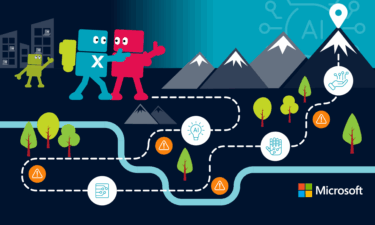Driving transformation with data modernisation

In the modern business landscape, data is everything. From enhancing decision-making to boosting personalisation strategies, information holds the power to transform a company’s performance and its ability to deliver value for customers. As more and more businesses pursue data-driven growth, their data storage needs, naturally, increase. But this can also compound pre-existing problems from legacy data systems.
At the same time, the emergence of larger and more varied data types means that IT staff, CIOs, compliance and data officers among others need to carry out proper data management and governance.
To solve this problem, companies can use data modernisation services to create a unified ecosystem of data — equipped to be accessible and supporting cross-departmental collaboration. But what exactly is modernisation, and what strategies allow a business to properly leverage it? Read on to learn all you need to know.
What is data modernisation?
Organisations have been grasping the potential of Big Data for many years. In the late 2000s and early 2010s, data ‘modernisation’ started to gain traction as cloud computing and advanced analytics became more widely used. These data management initiatives included data integration and analytics, which help companies organise and optimise their data as a key asset.
Today, many companies are eager to take advantage of the potential of data and cloud technology. But many still struggle with the problems of legacy data management systems — e.g. siloed systems, outdated technology, lack of transparency, etc.
Data modernisation addresses these challenges by transitioning an organisation’s systems from rigid and siloed to open and centralised. In doing so it boosts the value of a company’s data, making sure it is fully accessible to whoever needs it, secure, and used to its maximum potential.
What is data-first modernisation?
Data-first modernisation is a multi-step process of modifying access to data to boost business intelligence and decision-making. Like data modernisation, it breaks down data silos and moves it to a cloud-based operational model.
But ‘data-first’ takes its name from its more fundamental approach. It sees data as the foundational organising principle of a business. By applying the right resources in the right way, an organisation can correctly cultivate, connect, manage, analyse and make decisions from its data and gain a competitive edge over its rivals. The digital transformation is less about the data infrastructure than the creation of value for the organisation through data.
Intelligence Reporting
Modern business intelligence practices combine analytics, data mining, visualisation and other tools and infrastructure to effectively analyse and manage business data. However, as the volume of Big Data required and used by an enterprise expands, it becomes harder to validate, store and scale with legacy systems and outdated workflows. Additionally, it becomes harder to validate, store and scale information securely and effectively
Programming & processing
In the recent past companies and other organisations have used a variety of data integration tools and custom SQL scripts to process their data. But traditional on-premise processes are no longer able to fully deal with the multitude of different data formats, or enable the proper scalability needed to be an entirely digital organisation.
The benefits of data modernisation
- Decision Making
Real-time access to data allows people to make faster and more informed decisions. When access is granted properly, data becomes more democratised. This means people can more easily use self-service environments to collaborate, develop and share ideas and learnings. - AI Adoption
AI-powered innovations have come to the forefront of business intelligence. Having robust and sophisticated data strategies is important not just for managing diverse information sources — it also primes an organisation to adopt AI-driven analytics. This gives businesses a significant edge: more advanced algorithms lead to greater insights, which can reveal untapped patterns and trends and untangle complex data relationships. - Operational Efficiency
If data systems are outdated, users find it harder to manage growing volumes and maintain visibility over data quality. This leads to inconsistencies and inaccuracies, which can have deep consequences on operations. Proper integration and modernisation practices streamlines workflow and assists teams to configure resources faster and more consistently, helping boost ROI. - Database Reliability
When modern governance and data management practices are followed, trust is built. By improving data quality across an organisation, this helps construct scalable and agile processes to reduce costs and increase margins. - Security & Regulatory Compliance
Through up to date data governance practices —i.e. advanced monitoring, multi-factor authentication, access controls and encryption tools — an organisation can ensure that changes in datasets meet privacy and security requirements. The right software can, crucially, support IT security to capture data without interrupting workflow.
How is data modernised?
There are several important elements in contemporary data modernisation: integration, cleansing, consolidation, transformation, governance, analytics and visualisation. These elements are streamlined in the following ways:
Integration
Data comes from many different sources and varies : customers, partners, suppliers, or internally. Structured, semi-structured and unstructured data can be found across supply chain databases, ERP systems, CRM systems and customer or other third-party APIs.
Integrating all these sources can be highly impactful for business growth. Where too much time is spent manually processing data, or even attempting to access data in the first place, data integration — usually with cloud-based solutions — lets companies access data faster and scale according to their needs. This is the first step in the modernisation process.
Cleansing
Here all the organisation’s is cleaned or ‘scrubbed’ — errors, duplicates, inaccuracies and inconsistencies are identified, corrected and eliminated. This enhances the total integrity of the datasets and its integrity so that any data used for analysis and decision-making is reliable, with no redundancies, and fully accurate. All data formats are standardised across the organisation.
Consolidation
A recent trend in the logistics industry is storing all items in one warehouse and properly organising them to improve access and make order fulfilment faster and efficient.
In the same way, data consolidation or ‘warehousing’ unifies information under one architecture (a database, warehouse or lake) to prepare it for real-time reporting and analysis. Categorising and labelling data in this way makes it easier for users across the organisation to retrieve it and effectively plan for the future.
Governance
The key obstacle to establishing proper data controls in an organisation often comes down to a lack of unified approach. The right modernisation strategy means everyone in an organisation should have access to the right data in order to gather intelligent insights.
Today’s data teams must effectively monitor the quality of data and manage metadata. Their aim is to reduce the risk associated with inadequate data management and the consequences of human error from manual processes. Modernised data governance involves assigning proper ownership and stewardship of data: defining roles and responsibilities of those who are accountable for the quality and integrity of specific data sets.
Visualisation
Most industries at some point need to use data visualisation to gain an overview of their data. Modernising data visualisation enhances an enterprise’s advanced analytics capability — creating sophisticated visuals help explain statistics and other intelligence that data scientists use in their analysis.
Automation
Acquiring data is the first step, but to retain a leading edge businesses and organisations need to advance the ways they store and process data. McKinsey found that ⅓ of CIOs choose to spend 20% of their budget on managing the challenges associated with legacy data sources (technical debt).
With AI-driven automated data modernisation, companies’ IT departments can continuously optimise operations and reduce costs by executing tedious, time-consuming repetitive tasks, or using AI support for data analytics to find and propose system improvements.
What does the cloud do in modernisation?
The cloud is both a facilitator and a key result of data modernisation. A report from Deloitte points this out more clearly: ‘cloud migration and data modernisation are mutually reinforcing trends — they seem to support and overlap each other’.
Many organisations, for example, already use the cloud to store data, and those that do not are nearly all planning to migrate in the future. While it is possible to only modernise data stored on-premises, cloud data is inevitably a feature of most company’s modernisation strategies as even on-premise information is accessed through platforms that also use cloud technology.
Become a data-driven organisation
Xpedition can help driven transformation with data modernisation, breaking down data silos, boosting governance and advancing your business’s data analytics capabilities. Talk to us today to find out how you can gain a leading edge and find the best talent.



